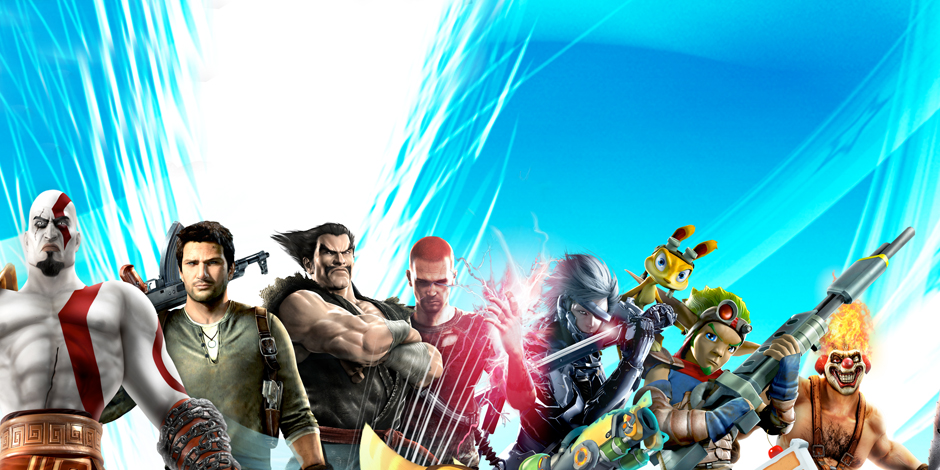GamesRadar+ Verdict
Pros
- +
Stellar presentation
- +
Fantastic Sony fan service
- +
More beginner-friendly than most four-player melees
Cons
- -
The path to victory isnt always all that satisfying
- -
Wrestling with the controls
- -
Sometimes-spotty hit detection
Why you can trust GamesRadar+
Sweet Tooth, Dante, and Sackboy are now co-stars in the same game. Let that bizarre reality sink in for a moment. In PlayStation All-Stars: Battle Royale, Sony and SuperBot Entertainment take a crack at the four-player, item-centric fighting game genre, popularized by Nintendo's Smash Bros. franchise. This mega-crossover incorporates characters from a wide array of PlayStation franchises (you can read the entire roster if you want), ranging from the hotly anticipated (Metal Gear Rising, DmC) to the pleasantly obscure (MediEvil, Ape Escape). But be warned: If you’re expecting a one-to-one facsimile of Smash Bros. with Kratos and Parappa in place of Mario and Fox, you'll be both pleasantly surprised and mildly disappointed.
The 20-strong roster of fighters pulls inspiration from all over the PlayStation timeline, borrowing items from Mark of Kri, stage designs from LocoRoco, and third-party pugilists like Heihachi Mishima from Tekken, among dozens of other titles. The stages especially capitalize on the various game licenses to great effect, mashing up unalike game worlds to create some wonderfully inventive battlefields. You’ll experience certain glee watching Twisted Metal’s Dollface terrorize BioShock Infinite’s Columbia, or grooving to the soothing sounds of Hot Shots Golf as Jak and Daxter’s stage gets pelted by incoming golf balls. Most backdrops feel like living dioramas, and the ingenious scenarios concocted for each arena one-up Nintendo’s single-franchise stages.
PlayStation fans will be pleased to know that SuperBot has managed to successfully capture the personality and charm of the disparate cast. For instance, Parappa can launch into an “I gotta believe!” rap concert, Nathan Drake unearths the El Dorado sarcophagus to curse his opponents, and Sly Cooper can call in Murray for some belly-slamming backup. Each of these cinematic assaults is an all-important Super Attack, attained by building up your All-Star Power bar with each hit you land to the opponent's chin. The only way to score kills--and therefore points--is to connect with Supers, all while trying to avoid score-depleting deaths yourself.
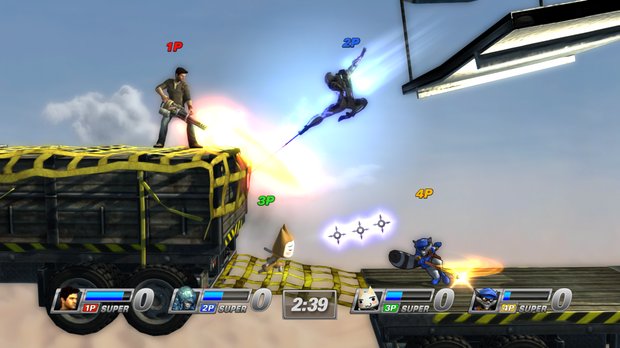
The fixation on Supers exacerbates just how unreliable some of the Super Attacks really are, and how the game’s hitboxes might frustratingly defy your expectations. Level 1 Supers are a gamble, rarely scoring kills since they can be interrupted with a single hit. Level 2s have a wider range of effectiveness--though some, like Kratos’ vertical vortex, feel like they have very limited use. Level 3s take quite a while to attain, but when you activate yours, it basically gives you free reign to murder your rivals as you ruin the lives of all but the most skilled air-dodgers.
What ends up happening is that characters with incredibly powerful Level 1s, like Sly Cooper, experience a much faster and exciting pace of play, leaping into the fray knowing that the potential for kills is mere moments away. But other Level 1s, like Heihachi’s, are near-pointless due to their miniscule hitbox and/or slow start, forcing the player to bide their time and making their experience an oscillation between exciting highs and frustrating lows.
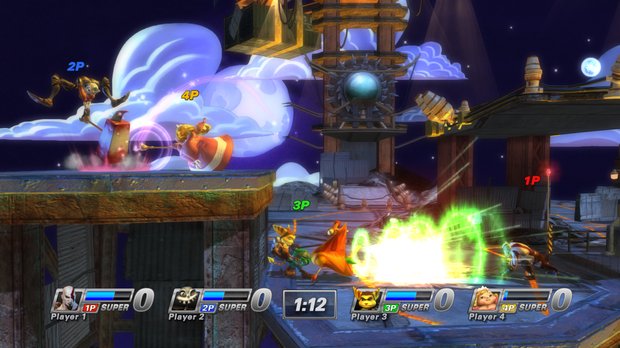
Past their referential movelists and Super Attacks, the enjoyment you’ll get from each fighter will be wildly varied. Some characters, like Dante and Sir Daniel, move and attack with a tangible stiffness, while Fat Princess’ beatdowns feel floaty and unresponsive. Yes, each All-Star should have a unique “feel” to them, but the discrepancy between the way some characters play makes transitioning between them a bear.
The tight controls do serve a purpose: All-Stars embraces the concept of dependable combos, with easy-to-memorize inputs and timing akin to technical brawlers like Street Fighter. Instead of the on-the-fly calculations needed to connect consecutive hits in a game like Smash Bros., All-Stars has reliable attack strings that will, for the most part, usually work once you’ve mastered them. However, the emphasis on Supers Attacks means that all the combat that unfolds between Super Attacks feels devalued and barely relevant to your final score. Getting hit by something that isn’t a Super Attack isn’t a threat--it’s more of an annoyance.
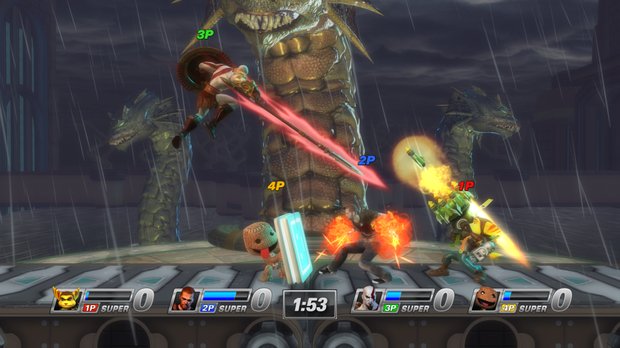
All-Stars also includes full-fledged online matchmaking, complete with tournament seasons, account progression (by way of colored belts), and leaderboards. Competitive ranked matches come in the four-player free-for-all or 2v2 variety, with each mode highlighting different strengths and weaknesses of each pugilist. Happily, most matches are lag-free, and a level 200 player has no direct advantage over a fresh account. In addition, All-Stars supports the increasingly popular CrossPlay feature, so a purchase on the PS3 or Vita will unlock the full game for the other system.
Though the Arcade Mode cutscenes are limited to still images with voiceovers, the “rival battles” that unfold between your favorite characters are a treat. Watching a drill-armed Big Daddy get jealous of Sackboy for capturing the Little Sister’s affection is absolutely adorable. There are also some single-player challenge modes to tide you over before the four-player party arrives, though they’re really not all that fun.
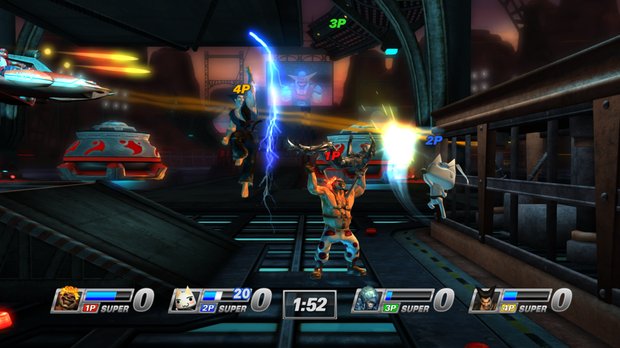
SuperBot also included a full-fledged tutorial mode to walk you through each character’s movelist and suggested combos--a feature that’s become standard in traditional fighters but feels refreshingly generous in a fighting game of this type. There’s also plenty to unlock (though the count is nowhere near the obscene number of Smash Bros. trophies), including new costumes, taunts, player icons, and cutesy Minions like P.J. Berri or Kuma that cheer you on from the sidelines.
For whatever inconsistencies it may have, All-Stars is still a blast to play with friends, and being able to take the bombastic brawling online can only bolster the game’s fun factor. But All-Stars ends up feeling a little unsure of itself, trying to identify with technical one-on-one fighters and the spontaneous scrapping of Smash Bros. in a way that doesn’t completely capture the joys of either. Gripes aside, Battle Royale lays the groundwork for what could be a truly stellar sequel.
This game was reviewed on the PS3.
Editor's Note: As part of our peer-review process, discussion of PlayStation All-Stars Battle Royale's offline and single-player modes was inadvertently removed. The review has since been amended with that information. GamesRadar regrets the error.
More info
| Genre | Fighting |
| Description | An upcoming crossover fighting game exclusively for PS3 and PS Vita, mainly containing playable characters from Sony franchises as well as some 3rd party franchises like Bioshock... |
| Platform | "PS3","PS Vita" |
| US censor rating | "Teen","" |
| UK censor rating | "","" |
| Release date | 1 January 1970 (US), 1 January 1970 (UK) |
Lucas Sullivan is the former US Managing Editor of GamesRadar+. Lucas spent seven years working for GR, starting as an Associate Editor in 2012 before climbing the ranks. He left us in 2019 to pursue a career path on the other side of the fence, joining 2K Games as a Global Content Manager. Lucas doesn't get to write about games like Borderlands and Mafia anymore, but he does get to help make and market them.
